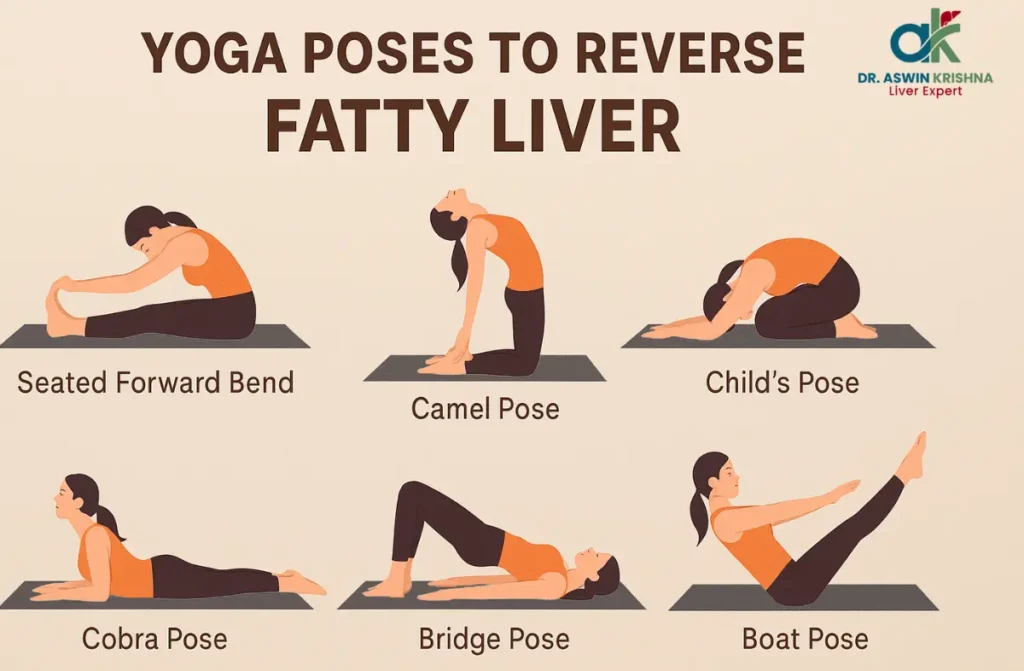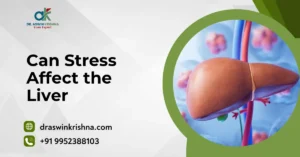The liver—our body’s silent multitasker—works tirelessly to filter toxins, process nutrients, and regulate metabolism. But when fat begins to build up in this vital organ, it quietly signals distress—a condition known as fatty liver. Often unnoticed until symptoms worsen, it affects both body and mind. Yoga for fatty liver offers a natural path to healing, combining mindful movement, deep breathing, and relaxation to rejuvenate liver cells and restore internal balance.
How to Practice Yoga for Liver Health
Practicing Yoga for fatty liver is not about intensity—it’s about awareness, rhythm, and consistency. Gentle, mindful movements combined with controlled breathing can help detoxify the liver and boost circulation. Whether you’re new to yoga or experienced, these practices encourage better digestion, emotional balance, and overall vitality.
Here’s how to integrate Yoga for liver health into your daily life:
- Start Your Practice Mindfully: Begin each session with a few minutes of deep breathing or meditation. This calms the nervous system, reduces cortisol levels, and prepares the body to release toxins. The liver thrives in a relaxed state, so entering your practice with calm focus enhances its effectiveness.
- Focus on Twisting Postures: Twists such as Ardha Matsyendrasana (Half Lord of the Fishes Pose) gently compress the abdominal area, stimulating the liver and gallbladder. When you release the twist, oxygenated blood floods the organ, promoting regeneration and detoxification—making it excellent Yoga for enlarged liver conditions.
- Incorporate Forward Bends: Forward bends like Paschimottanasana (Seated Forward Bend) improve digestion and help massage internal organs. These poses reduce belly fat accumulation and encourage better liver enzyme function, making them beneficial for those dealing with fatty liver concerns.
- Combine Breathing Techniques with Movement: Pairing slow, rhythmic breathing with poses enhances oxygen delivery and supports the liver’s detoxifying functions. Techniques like Nadi Shodhana (alternate nostril breathing) and Bhramari (humming breath) are particularly effective in promoting liver vitality.
- End with Restorative Poses: Conclude your routine with restorative postures such as Viparita Karani (Legs Up the Wall). This encourages blood circulation to vital organs and induces deep relaxation—allowing the liver to rejuvenate and repair naturally.
Why Yoga Supports Liver Health
The connection between yoga and liver wellness runs deeper than flexibility or movement—it’s about creating harmony between the body’s internal systems. Practicing Yoga for fatty liver helps regulate metabolism, reduce stress, and improve circulation—all of which directly support liver repair and function. Let’s explore how Yoga for liver strengthens this vital organ from within:
- Enhances Blood Flow and Detoxification: Yoga postures improve blood circulation, ensuring a steady supply of oxygen and nutrients to the liver. Twisting and bending poses gently massage the organ, enhancing its ability to flush out toxins and regenerate damaged tissues—an essential step for those with Yoga for enlarged liver needs.
- Reduces Stress-Induced Liver Damage: Chronic stress increases cortisol levels, which can impair liver function over time. Yoga incorporates mindful breathing and meditation, which soothe the nervous system and balance hormones, allowing the liver to perform its detoxification duties more efficiently.
- Improves Digestion and Metabolic Balance: Many yoga poses stimulate abdominal organs, aiding bile secretion and digestion. Improved digestion means fewer toxins in the bloodstream, reducing the liver’s workload and preventing fat accumulation—making Yoga for fatty liver both preventive and therapeutic.
- Regulates Weight and Fat Storage: Consistent yoga practice encourages mindful eating, better metabolism, and gradual fat loss. Since excess body fat often contributes to fatty liver disease, yoga indirectly restores liver health by addressing the root cause.
- Boosts Emotional and Energetic Balance: According to traditional yoga philosophy, the liver is linked to suppressed anger and frustration. Regular practice helps release emotional tension, bringing calmness and clarity—factors that play a crucial role in long-term liver wellness.

5 Best Restorative Yogasanas for Fatty Liver
Restorative yoga postures allow the body to rest, heal, and rebuild energy—making them powerful tools for liver recovery. When practiced gently and consistently, these asanas enhance detoxification, improve circulation, and restore internal harmony. Below are the Best yoga for liver health and vitality:
1. Supine Spinal Twist (Supta Matsyendrasana)
This gentle twist compresses and massages the liver, promoting the removal of toxins and stimulating fresh blood flow upon release. As one of the most effective yoga poses for liver, it supports digestion and relieves bloating. It also calms the mind, reducing stress—a hidden contributor to liver disorders.
2. Bridge Pose (Setu Bandhasana)
The Bridge Pose strengthens abdominal muscles and stretches the chest and spine, improving blood circulation to the liver. Practicing this Yoga for liver health regularly can help reduce fat buildup and balance metabolic activity. It’s especially beneficial for those managing Yoga for fatty liver and Yoga for liver disease, as it rejuvenates the entire abdominal region.
3. Cobra Pose (Bhujangasana)
This heart-opening posture expands the chest and massages the digestive organs, improving liver and gallbladder function. Cobra Pose is ideal for Yoga for enlarged liver and Yoga for cirrhosis of liver as it strengthens the back while gently compressing the abdomen, enhancing oxygen supply to the liver. Practicing this asana daily aids natural detoxification.
4. Seated Forward Bend (Paschimottanasana)
A deeply calming pose, it helps in reducing abdominal fat and stimulating the liver and pancreas. This Yoga for liver pain posture releases physical and emotional tension, supporting better energy flow. It also aids digestion, making it valuable for those struggling with Yoga for fatty liver or sluggish metabolism.
5. Legs Up the Wall Pose (Viparita Karani)
One of the most restorative Yoga for liver cirrhosis postures, it enhances venous blood return and allows the liver to rest and rejuvenate. This gentle inversion promotes detoxification, balances hormones, and relieves fatigue. It’s a simple yet powerful Yoga for healthy liver that can be done by anyone, even beginners, to restore internal equilibrium and vitality.
Additional Tips for Keeping the Liver Healthy with Yoga
Maintaining liver health requires more than just postures—it’s about adopting a lifestyle that complements the body’s natural rhythms. Practicing Yoga for fatty liver can be deeply effective when paired with mindful habits that support long-term healing and regeneration. Here are some essential ways to enhance your yoga journey and sustain liver vitality:
- Practice Consistency Over Intensity: The liver responds better to steady, gentle movement than to strenuous activity. Aim for daily sessions of 20–30 minutes rather than occasional long workouts. Consistent practice of yoga poses for liver ensures gradual fat reduction, improved circulation, and enhanced detoxification.
- Focus on Breathing Techniques (Pranayama): Breathing exercises like Kapalbhati and Anulom Vilom cleanse the respiratory system and improve oxygenation, directly benefiting the liver. These techniques, when combined with Yoga for liver disease, help purify the blood and reduce toxins—making the organ function more efficiently.
- Eat in Alignment with Yoga Principles: Support your yoga routine with a clean, plant-based diet. Fresh fruits, leafy greens, and warm water with lemon assist in natural liver detox. Avoiding processed food, alcohol, and excess sugar ensures that your Yoga for liver health efforts are not undone by poor dietary choices.
- Hydrate and Rest Adequately: Water helps flush out toxins that yoga dislodges from the tissues. Ensure you drink enough fluids throughout the day. Adequate sleep is equally crucial—rest enables the liver to repair itself, especially after engaging in Yoga for fatty liver sessions.
- Listen to Your Body’s Signals: Avoid overexertion or discomfort in poses. If you feel pressure or pain in the abdomen, pause and shift to restorative poses like Viparita Karani or Savasana. Respecting the body’s limits allows your Best yoga for liver practice to be both healing and sustainable.
Who Can Benefit from This Routine?
The beauty of Yoga for fatty liver lies in its adaptability—anyone can begin, regardless of age or fitness level. Whether you’re healing from liver issues or preventing them, this routine offers holistic benefits that go beyond physical wellness. Here’s who can gain the most from practicing these gentle, liver-nourishing postures:
- Individuals Diagnosed with Fatty Liver Disease: Those with mild to moderate fatty liver can experience significant improvements through Yoga for enlarged liver and Yoga for liver disease practices. Regular yoga reduces fat accumulation, enhances bile secretion, and improves enzyme balance, supporting natural liver repair without invasive treatments.
- Overweight or Sedentary Adults: People with inactive lifestyles or poor dietary habits often struggle with sluggish liver function. Incorporating yoga poses for liver encourages fat metabolism, improves digestion, and reduces stress-related cravings—making it ideal for gradual lifestyle transformation.
- Individuals Recovering from Liver Disorders: Gentle postures like Viparita Karani and Supta Matsyendrasana promote circulation and healing for those recovering from hepatitis or Yoga for cirrhosis of liver conditions. These restorative asanas help the liver regain strength while minimizing fatigue.
- Health-Conscious Individuals Seeking Prevention: Practicing Yoga for liver health is not just for the unwell—it’s preventive care in its purest form. It detoxifies the system, balances emotions, and maintains hormonal equilibrium, ensuring long-term vitality and resilience.
- Those Experiencing Digestive or Emotional Imbalances: The liver is deeply connected to digestion and emotional stability. Individuals who often feel irritable, fatigued, or bloated can benefit from Yoga for healthy liver practices that release tension, balance mood, and improve energy levels.
Conclusion
The path to liver healing begins with awareness—and yoga offers the most natural, compassionate way to restore that balance. Through mindful movements, deep breathing, and relaxation, Yoga for fatty liver helps the body detoxify, rejuvenate, and find harmony from within. It’s not just about flexibility; it’s about nurturing your inner rhythm and giving your liver the care it silently deserves.
Take a step onto the mat, breathe deeply, and let yoga guide your liver back to health—one gentle pose at a time.



